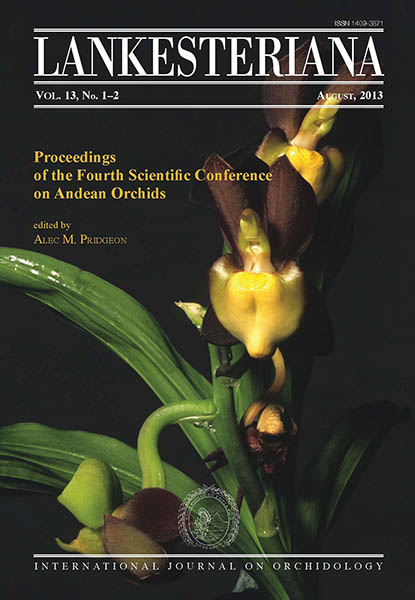<i>Tulasnella irregularis</i> (basidiomycota: tulasnellaceae) from roots of <i>Encyclia tampensis</i> in south Florida, and confirmation of its mycorrhizal significance through symbiotic seed germination
DOI:
https://doi.org/10.15517/lank.v0i0.11552Keywords:
conservation, epiphytic orchids, mycorrhizal relationships, physiology, its sequencing, basidiomycota, tulasnella irregularis, encyclia tampensis, epidendrumAbstract
Epiphytic orchids remain understudied with respect to their obligate mycorrhizal relationships – a key component of the integrated conservation model. Existing studies have revealed that these plants, like their terrestrial counterparts, commonly associate with ubiquitous basidiomycetes (e.g., Tulasnellaceae); however, few studies have verified their physiological role(s). Two strains of mycorrhizal fungi (UAMH 11541, UAMH 11543) were isolated from roots of an epiphytic orchid in south Florida, Encyclia tampensis; one was acquired from a seedling and one from a mature specimen. Seeds of four epiphytic taxa were subsequently inoculated (separately) with both fungal strains in vitro: E. tampensis, Epidendrum amphistomum, Epidendrum nocturnum, and Prosthechea cochleata. More than one-third of inoculated E. tampensis and E. nocturnum seeds developed leaves in total darkness after 100 days. No significant differences were detected between the two strains on germination, nor any interaction between fungus and seed source (ANOVA, α = 0.05). Using ITS amplification and sequencing, both strains were identified as the teleomorph, Tulasnella irregularis (Basidiomycota: Tulasnellaceae), and both were genetically identical with a high (98%) degree of certainty. Thus, symbiotic germination and ITS sequencing results are in agreement that both strains are indeed the same fungus. This paper is meant to shed additional light into epiphytic orchid-fungal interactions and highlights the need to identify, test (through symbiotic germination) and safeguard mycorrhizal fungi necessary for conservation.Downloads
Download data is not yet available.
Downloads
How to Cite
Zettler, L. W., Corey, L. L., Jacks, A. L., Gruender, L. T., & Lopez, A. M. (2013). <i>Tulasnella irregularis</i> (basidiomycota: tulasnellaceae) from roots of <i>Encyclia tampensis</i> in south Florida, and confirmation of its mycorrhizal significance through symbiotic seed germination. Lankesteriana: International Journal on Orchidology, 13(1-2). https://doi.org/10.15517/lank.v0i0.11552
Issue
Section
Articles
License
According to the Open Access policy promoted by the University of Costa Rica, all the papers published by Lankesteriana are licensed under the Creative Commons copyright and can be downloaded free of charge. The journal holds copyright and publishing rights under the CC BY-NC-ND 3.0 CR license.
Before the publication of the materials submitted by the author(s) in LANKESTERIANA, the author(s) hereby assign all rights in the article to the Lankester Botanical Garden.





